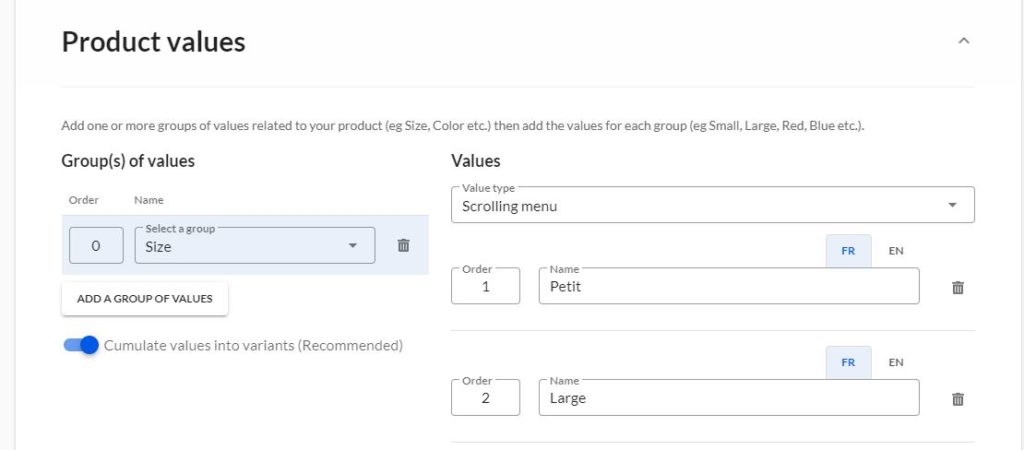What is the "Cumulate values into variants" button for?
In order to allow merchants to offer the most options for these products on a single product page, you can (or not) accumulate the values of your products in variants.
But what does this mean exactly? We explain to you!
To know before you start: This button is used for products with more than one value group. With only one set of values, the button will have no real impact.
Products with cumulative values in variants
Définition et exemple concret
When the cumulative values button is activated, it allows you to create variants of your products by adding the different groups of values. This is useful for not-customizable products, the values are not options to add or remove but rather characteristics of the product. You can put up to 3 groups of values.
For example (nothing better than concrete examples to understand):
You sell the same model of shoes in different colors and sizes.
So you have a group of values “Colors” with the values “Red“, “Blue” and “Green” and a group “Sizes” with the values “8“, “9” and “10“.
The following variants will therefore be created:
- Shoes in red, size 8
- Shoes in red, size 9
- Shoes in red, size 10
- Shoes in blue, size 8
- Shoes in blue, size 9
- Shoes in blue, size 10
- Shoes in green, size 8
- Shoes in green, size 9
- Shoes in green, size 10
Benefits
Manage your inventory by variants
In the previous example, you will have a defined quantity of red shoes in size 8, so you can associate an inventory with them. And this for each of the variants.
Customize the price by variants
You can associate a price and a different promotion price for each of the variants if you wish. For example, you don’t sell green shoes, promote these variations.
Assign an image to each variant
By adding an image for each variant, once the customer has chosen the desired values, the image representing their choice will be displayed as the main image. What could be more convincing than seeing the exact product you want to buy before putting it in the cart.
And more
- Assign a SKU for each of the variants
- Inform a different weight for each of the variants (useful when using external shipping services.)
Products with non-cumulative values
Definition and concrete example
When the cumulative values button is not activated, the values of the different groups of values do not add up and remain independent. This is useful for custom products and optional services that you want to add to your products.
For example (nothing better than concrete examples to understand):
You sell soaps, one of your products and a box of 3 soaps (to choose from 3 scents) with which the customer can write a note on the box.
In this case you have 5 groups of values:
- “Fragrance Note 1” with the values “Rose”, “Basil” and “Lavender”
- “Fragrance Note 2” with the values “Rose”, “Basil” and “Lavender”
- “Fragrance Note 3” with the values “Rose”, “Basil” and “Lavender”
- “Box Format “ with the values “Square”, “Round” and “Heart”
- “With custom word” with the values “Yes” and “No”.
Here no variants are created, for example you do not have a defined quantity of boxes with the choices: Rose, Basil, Rose, Round, No.
Benefits
Create more than 3 groups of values
When the values are cumulated in variants you are stuck with 3 groups of values. Without accumulating them, you can go up to 10 groups of values! This leaves you with a lot of possibilities.
The number of values in each group is unlimited with both options.
Manage more easily
Since variants are not created, you do not have to update dozens (or even hundreds) of variant rows. You manage a single price, a general quantity (or none) or even a single SKU.


